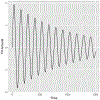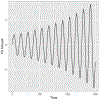Coregulation of therapist and client emotion during psychotherapy
- PMID: 32400306
- PMCID: PMC7233481
- DOI: 10.1080/10503307.2019.1661541
Coregulation of therapist and client emotion during psychotherapy
Abstract
Objective: Close interpersonal relationships are fundamental to emotion regulation. Clinical theory suggests that one role of therapists in psychotherapy is to help clients regulate emotions, however, if and how clients and therapists serve to regulate each other's emotions has not been empirically tested. Emotion coregulation - the bidirectional emotional linkage of two people that promotes emotional stability - is a specific, temporal process that provides a framework for testing the way in which therapists' and clients' emotions may be related on a moment to moment basis in clinically relevant ways.
Method: Utilizing 227 audio recordings from a relationally oriented treatment (Motivational Interviewing), we estimated continuous values of vocally encoded emotional arousal via mean fundamental frequency. We used dynamic systems models to examine emotional coregulation, and tested the hypothesis that each individual's emotional arousal would be significantly associated with fluctuations in the other's emotional state over the course of a psychotherapy session.
Results: Results indicated that when clients became more emotionally labile over the course of the session, therapists became less so. When changes in therapist arousal increased, the client's tendency to become more aroused during session slowed. Alternatively, when changes in client arousal increased, the therapist's tendency to become less aroused slowed.
Keywords: dynamic systems; emotion coregulation; psychotherapy; therapeutic relationship.
Figures
References
-
- Aragón OR, Clark MS, Dyer RL, & Bargh JA (2015). Dimorphous expressions of positive emotion: Displays of both care and aggression in response to cute stimuli. Psychological Science, 26(3), 259–273. - PubMed
-
- Armstrong MJ, Mottershead TA, Ronksley PE, Sigal RJ, Campbell TS, & Hemmelgarn BR (2011). Motivational interviewing to improve weight loss in overweight and/or obese patients: a systematic review and meta‐analysis of randomized controlled trials. Obesity Reviews, 12(9), 709–723. - PubMed
-
- Bates D, Mächler M, Bolker B, & Walker S (2014). Fitting linear mixed-effects models using lme4. arXiv preprint arXiv:1406.5823
-
- Beck AT, Rush AJ, Shaw BF, & Emery G (1979). Cognitive Therapy for Depression The Guilford Press: New York, NY.
Publication types
MeSH terms
Grants and funding
LinkOut - more resources
Full Text Sources


